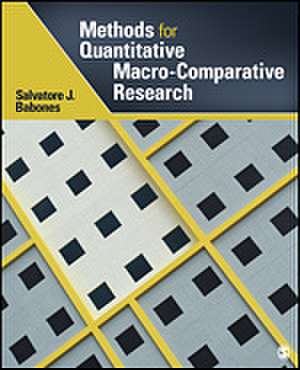Methods for Quantitative Macro-Comparative Research
Autor Salvatore J. Babonesen Limba Engleză Paperback – 16 sep 2013
Preț: 714.15 lei
Preț vechi: 978.29 lei
-27% Nou
Puncte Express: 1071
Preț estimativ în valută:
136.66€ • 141.76$ • 113.95£
136.66€ • 141.76$ • 113.95£
Carte tipărită la comandă
Livrare economică 27 martie-10 aprilie
Preluare comenzi: 021 569.72.76
Specificații
ISBN-13: 9781412974950
ISBN-10: 141297495X
Pagini: 296
Ilustrații: illustrations
Dimensiuni: 187 x 232 x 16 mm
Greutate: 0.5 kg
Ediția:New.
Editura: SAGE Publications
Colecția Sage Publications, Inc
Locul publicării:Thousand Oaks, United States
ISBN-10: 141297495X
Pagini: 296
Ilustrații: illustrations
Dimensiuni: 187 x 232 x 16 mm
Greutate: 0.5 kg
Ediția:New.
Editura: SAGE Publications
Colecția Sage Publications, Inc
Locul publicării:Thousand Oaks, United States
Recenzii
“There isn’t any text I am aware of like this, and as the author notes, there is an increasing amount of interest in this area, so a text is needed.”
—Richard York, University of Oregon
“All too often statistical analysis texts lose sight of the reasons for conducting the research in the first place, but that is certainly not the case here…The chapters thus far actually go far beyond much of the current work by both synthesizing a wide variety of material and explicitly dealing with many of the taken for granted assumptions…All of the writing is quite clear, even when it verges into quite complex methodological territory. The examples are well chosen.”
—Buster Smith, Catawba College
“This should be required reading for World Bank, OECD and U.N. researchers and data collectors as well as applied and academic sociologists, economists, political scientists and others who conduct cross country comparisons using publicly available large datasets.
—Ernesto Castañeda, University of Texas at El Paso
“I really don’t know how the author has managed it, but he covers complex material in an incredibly clear way…I think students who have a weaker background in statistics will learn a lot from the text and students with an advanced background in statistics will look at their analyses in a different way (from the point of planning analyses to actually interpreting results).”
—Lesley Williams Reid, Georgia State University
“I suspect this book will greatly enhance the teaching and practice of rigorous macro-level comparative analysis. It is a welcome addition to the teaching and training of future comparativists…I like very much the author’s courage in directly assessing and sometimes challenging the existing literature…This book must be taken seriously by all students of comparative politics. One can learn a great deal from it—it is a “big picture” book, covering well and widely the current state of research and analysis utilizing macro-approaches to the study of comparative politics.”
—Thomas Lancaster, Emory University
“The author explains complex concepts very well. Indeed, I found this far easier to read than most discussions of statistical methods.”
—Laura Hatcher, Southern Illinois University
“This is a book of PRIZE WINNING quality…It is also a profoundly original, highly convincing and very innovative attempt to reformulate macro methods to avoid the pitfalls of the clichéd solutions that have filled macro journals with sloppy unconvincing pseudo-scientific analyses for the last twenty years.”
—Samuel Cohn, Texas A&M University
—Richard York, University of Oregon
“All too often statistical analysis texts lose sight of the reasons for conducting the research in the first place, but that is certainly not the case here…The chapters thus far actually go far beyond much of the current work by both synthesizing a wide variety of material and explicitly dealing with many of the taken for granted assumptions…All of the writing is quite clear, even when it verges into quite complex methodological territory. The examples are well chosen.”
—Buster Smith, Catawba College
“This should be required reading for World Bank, OECD and U.N. researchers and data collectors as well as applied and academic sociologists, economists, political scientists and others who conduct cross country comparisons using publicly available large datasets.
—Ernesto Castañeda, University of Texas at El Paso
“I really don’t know how the author has managed it, but he covers complex material in an incredibly clear way…I think students who have a weaker background in statistics will learn a lot from the text and students with an advanced background in statistics will look at their analyses in a different way (from the point of planning analyses to actually interpreting results).”
—Lesley Williams Reid, Georgia State University
“I suspect this book will greatly enhance the teaching and practice of rigorous macro-level comparative analysis. It is a welcome addition to the teaching and training of future comparativists…I like very much the author’s courage in directly assessing and sometimes challenging the existing literature…This book must be taken seriously by all students of comparative politics. One can learn a great deal from it—it is a “big picture” book, covering well and widely the current state of research and analysis utilizing macro-approaches to the study of comparative politics.”
—Thomas Lancaster, Emory University
“The author explains complex concepts very well. Indeed, I found this far easier to read than most discussions of statistical methods.”
—Laura Hatcher, Southern Illinois University
“This is a book of PRIZE WINNING quality…It is also a profoundly original, highly convincing and very innovative attempt to reformulate macro methods to avoid the pitfalls of the clichéd solutions that have filled macro journals with sloppy unconvincing pseudo-scientific analyses for the last twenty years.”
—Samuel Cohn, Texas A&M University
Cuprins
PART I: MACRO-COMPARATIVE DATA STRUCTURES
1. The Logic of Macro-Comparative Research
2. The International Data Infrastructure
3. Variable Operationalization
4. The Structure of Country Data
PART II: STATISTICAL ANALYSIS OF MACRO-COMPARATIVE DATA
5. Statistical Modeling with Cross-Sectional Designs
6. Structured and Longitudinal Designs for Establishing Causality
7. Repeated Measures and Multilevel Modeling
8. An Interpretive Research and Policy Framework
Conclusion: The Political Economy of Quantitative Macro-Comparative Research
1. The Logic of Macro-Comparative Research
2. The International Data Infrastructure
3. Variable Operationalization
4. The Structure of Country Data
PART II: STATISTICAL ANALYSIS OF MACRO-COMPARATIVE DATA
5. Statistical Modeling with Cross-Sectional Designs
6. Structured and Longitudinal Designs for Establishing Causality
7. Repeated Measures and Multilevel Modeling
8. An Interpretive Research and Policy Framework
Conclusion: The Political Economy of Quantitative Macro-Comparative Research
Notă biografică
Descriere
Will a one-child policy increase economic growth? Does globalization contribute to global warming? Are unequal societies less healthy than more egalitarian societies? It is questions like these that social scientists turn to quantitative macro-comparative research (QMCR) to answer.








